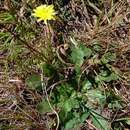en
names in breadcrumbs


Hypochaeris radicata (sometimes spelled Hypochoeris radicata) – also known as catsear, flatweed,[1][2] cat's-ear,[3] hairy cat's ear,[4] or false dandelion – is a perennial, low-lying edible herb often found in lawns. The plant is native to Europe,[5] but has also been introduced to the Americas,[6][7][8] Japan,[9] Australia,[10] and New Zealand, where it can be an invasive weed. It is listed as a noxious weed in the northwestern U.S. state of Washington.[11]
The leaves, which may grow up to eight inches (20 cm) long, are lobed and covered in coarse hairs, forming a low-lying rosette around a central taproot. Forked stems carry bright yellow flower heads, and when mature these form seeds attached to windborne "parachutes". All parts of the plant exude a milky sap when cut.[12]
Hypochaeris species are used as food plants by the larvae of some Lepidoptera species including the shark moth.
Its name is derived from Greek ὑπό 'under' and χοῖρος 'young pig'. Thus the name "should" be spelled Hypochoeris. The adjective radicata means 'with conspicuous roots' in Latin (derived from radix 'root').
In English, catsear is derived from the words cat's ear, and refers to the shape and fine hair on the leaves resembling that of the ear of a cat.
The plant is also known as false dandelion because it is commonly mistaken for true dandelions. Both plants carry similar flowers which form windborne seeds. However, catsear flowering stems are forked and solid, whereas dandelions possess unforked stems that are hollow. Both plants have a rosette of leaves and a central taproot. The leaves of dandelions are jagged in appearance, whereas those of catsear are more lobe-shaped and hairy. Both plants have similar uses.
All parts of the catsear plant are edible; however, the leaves and roots are those most often harvested. The leaves are bland in taste but can be eaten raw in salads, steamed, or used in stir-fries. Some recommend mixing them with other vegetables.[13] Older leaves can become tough and fibrous, but younger leaves are suitable for consumption. In contrast to the edible leaves of dandelion, catsear leaves only rarely have some bitterness. In Crete, Greece, the leaves of a variety called παχιές (pachiés) or αγριοράδικα (agriorádika) are eaten boiled or steamed.[14]
The root can be roasted and ground to form a coffee substitute.
This species is suspected of causing stringhalt in horses if consumed in excess.[15][16] See video of the Bondi Vet re. toxicity: https://www.youtube.com/shorts/apkQfBgs7_E as to how it has affected a donkey.
 Hypochaeris radicata yellow flowers
Hypochaeris radicata yellow flowers Hypochaeris radicata (sometimes spelled Hypochoeris radicata) – also known as catsear, flatweed, cat's-ear, hairy cat's ear, or false dandelion – is a perennial, low-lying edible herb often found in lawns. The plant is native to Europe, but has also been introduced to the Americas, Japan, Australia, and New Zealand, where it can be an invasive weed. It is listed as a noxious weed in the northwestern U.S. state of Washington.